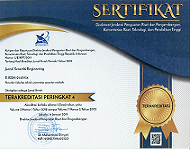Pemungutan Kalsium Oksida (CaO) sebagai Adsorben dari Berbagai Jenis Cangkang dengan Proses Kalsinasi
Keywords:
calcium oxide, shell, calcination, adsorbent, morphologyAbstract
Calcium oxide (CaO) is the result of the combustion of calcium carbonate (CaCO3) through a calcination process. It can be utilized as an adsorbent. CaO has been demonstrated to be an effective adsorbent in a variety of applications, particularly in the domains of purification and waste treatment. The presence of calcium carbonate has been observed in various types of shells, including those of eggs and shellfish. The objective of this study is to analyze the calcium oxide produced in the shells of duck eggs, quail eggs, green mussels, rice paddy snails, and kupang. The study will employ XRF analysis to determine the shells that produce the highest calcium oxide. The present study employed a combustion time variation ranging from 24 to 120 minutes at an elevated temperature of 800°C. The results demonstrated that duck eggshells calcined for 120 minutes exhibited the highest calcium oxide content. Subsequent analysis using scanning electron microscopy (SEM) and UV-Vis spectrophotometry was conducted to ascertain the morphology and adsorption power. Consequently, the processing of shell waste has the dual benefits of reducing environmental impact and generating higher economic value through its utilization as an adsorbent.
References
[1] S. A. Putri, “Produksi Kolagen dari Limbah Membran Cangkang Telur Bebek dan Analisis Kandungan Hidroksiprolin Secara Kromatografi Cair Kinerja Tinggi-Fluoresensi,” Eggshells Res., vol. 1, no. 1, pp. 1–7, 2020.
[2] P. dan K. H. Dirjen, Statisitik. 2018. [Online]. Available: http://repository.widyamandala.ac.id/14%0A52/1/BAB I.pdf
[3] A. Sawiji and R. A. Perdanawati, “Pemetaan Pemanfaatan Limbah Kerang Dengan Pendekatan Masyarakat Berbasis Aset(Studi Kasus: Desa Nambangan Cumpat, Surabaya),” Mar. J., vol. 03, no. 01, pp. 10–19, 2017.
[4] B. P. Statistik, Statistik Kabupaten Sidoarjo. 2019. [Online]. Available: https://satudata.sidoarjokab.go.id/assets/document/DC20230831022046.pdf
[5] E. E. Ernawati, A. R. Novianti, and Y. B. Yulianti, “Potensi Cangkang Telur Sebagai Pupuk Pada Tanaman Cabai di Desa Sayang Kabupaten Jatinangor,” J. Pengabdi. Kpd. Masy. ISSN 1410-5675; eISSN 2620-8431, vol. 4, no. 2, pp. 129–132, 2019, [Online]. Available: http://jurnal.unpad.ac.id/pkm/article/view/26643/13802
[6] A. O. Maisyarah and A. S. Rudiyansyah, “Sintesis CaO dari Cangkang Kerang Ale Ale ( Meretrix meretrix ),” J. Kim. Khatulistiwa, vol. 8, no. 1, pp. 37–40, 2019.
[7] S. Oko, A. Kurniawan, and D. Angreni, “Pengaruh Massa Adsorben Blending CaO Dari Cangkang Telur dan Karbon Teraktivasi untuk Adsorpsi Zat Warna Methylene Blue,” Metana, vol. 18, no. 2, pp. 99–104, 2022, doi: 10.14710/metana.v18i2.49376.
[8] A. N. Lisdawati, “Pengaruh Variasi Suhu dan Waktu Kalsinasi pada Pembentukan Fasa ZrO2,” Tesis, pp. 1–64, 2015.
[9] A. Mukminin, M. Firdaus, Y. Yuniarti, and M. W. Syabani, “Pengaruh Waktu Kalsinasi Abu Cangkang Kelomang (Paguroidea) pada Suhu Tinggi Dalam Pembentukan Katalis Padat CaO,” Indones. J. Chem. Res., vol. 4, no. 1, pp. 1–8, 2019, doi: 10.20885/ijcr.vol4.iss1.art1.
[10] E. Rahayu, P. Luna, S. Usmiati, and S. Sunarmani, “Optimasi Sintesis dan Aplikasi Adsorben dari Limbah Ekstraksi Biosilika Sekam Padi,” War. Ind. Has. Pertan., vol. 38, no. 1, p. 36, 2021, doi: 10.32765/wartaihp.v38i1.6408.
[11] A. S. Lamuru, Mahirulla, and S. Juita, “Pengaruh Ukuran Partikel Serbuk Kalsium Oksida (CaO) Sebagai Adsorben Untuk Meningkatkan Kadar Etanol Teknis Effect of Calcium Oxide (CaO) powder particle size as adsorbent to increase technical ethanol levels,” J. Jejaring Mat. dan Sains, vol. 5, no. 1, pp. 1–5, 2023, [Online]. Available: https://doi.org/10.36873/jjms.2023.v5.i1.801
[12] Standar Nasional Indonesia 06-3730, Arang Aktif Teknis. Jakarta: Badan Standarisasi Nasional, 1995.
[13] M. Svensson, “Numerical modelling of calcination of limestone : An evaluation of existing calcination model,” p. 3, 2021, [Online]. Available: https://urn.kb.se/resolve?urn=urn:nbn:se:umu:diva-184517
[14] S. Sunardi, E. D. Krismawati, and A. Mahayana, “Sintesis dan Karakterisasi Nanokalsium Oksida dari Cangkang Telur,” ALCHEMY J. Penelit. Kim., vol. 16, no. 2, p. 250, 2020, doi: 10.20961/alchemy.16.2.40527.250-259.
[15] R. Lestari, R. Firyanto, and H. Sitompul, “Uji Daya Adsorpsi Adsorben Arang Biji Salak Untuk Menjerap Methylen Blue,” Inov. Tek. Kim., vol. 11, no. 2, pp. 99–103, 2024.
Downloads
Published
Issue
Section
License
Copyright (c) 2025 Adifa Azzajalla Robitu, Cut Difasya Auriely Tamami, Mutasim Billah (Author)

This work is licensed under a Creative Commons Attribution 4.0 International License.












